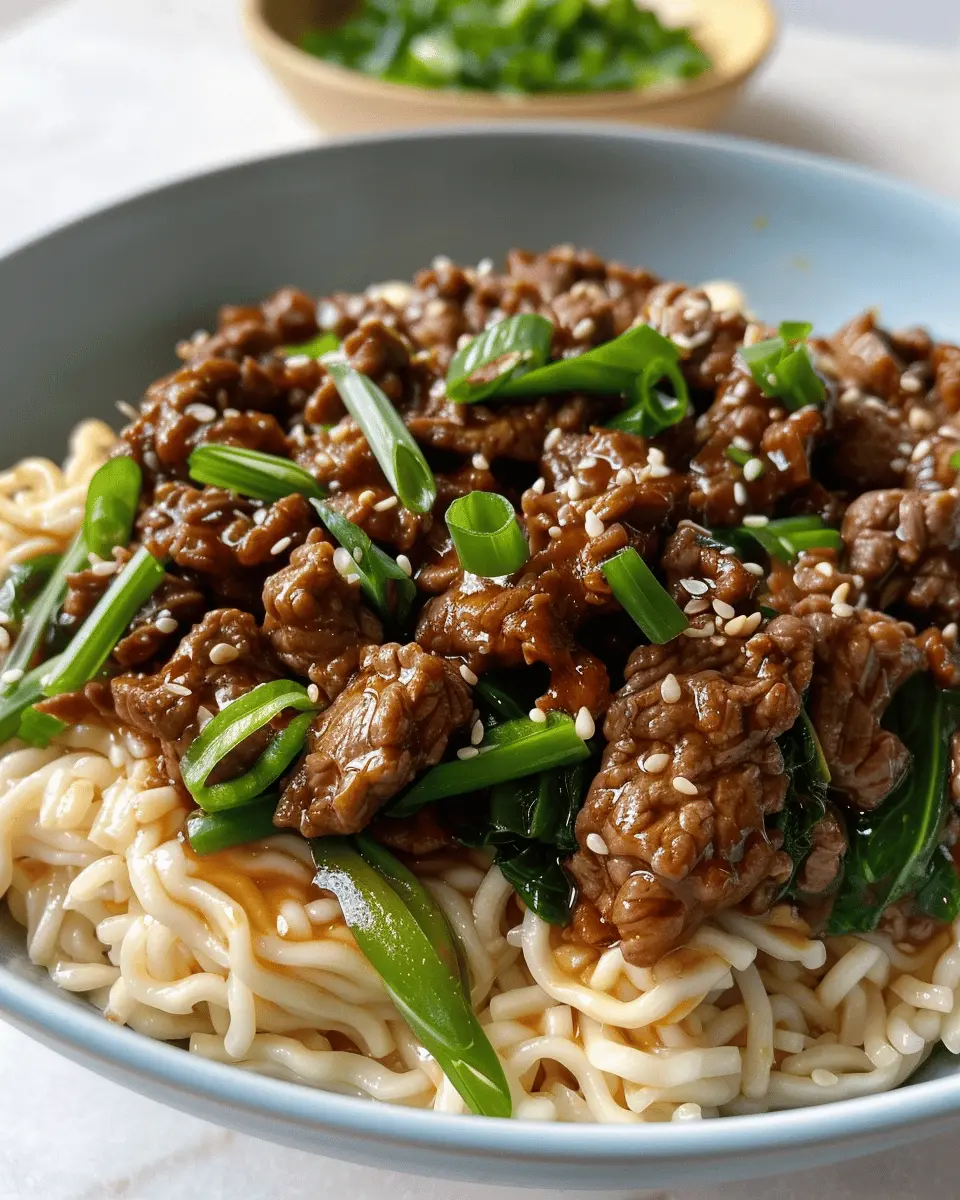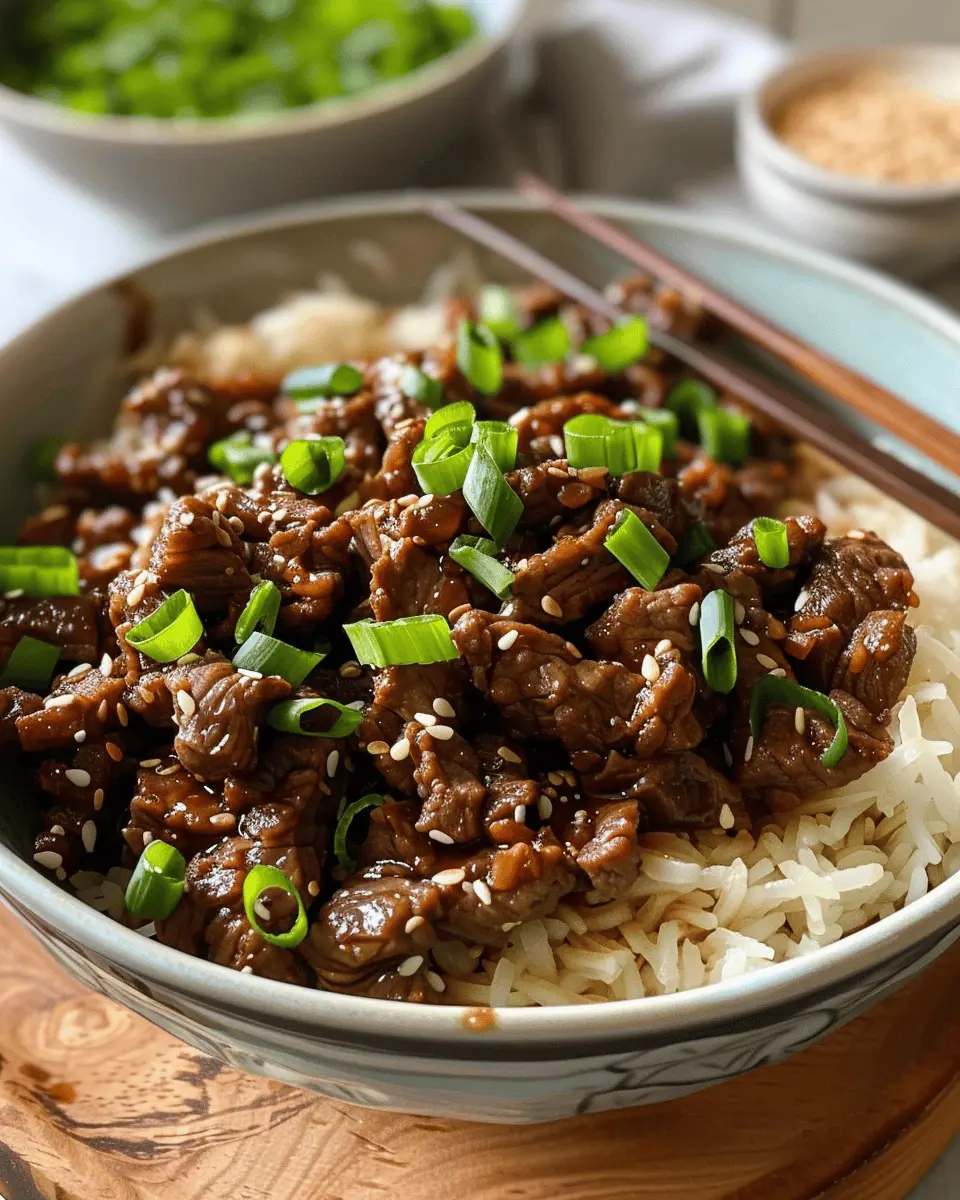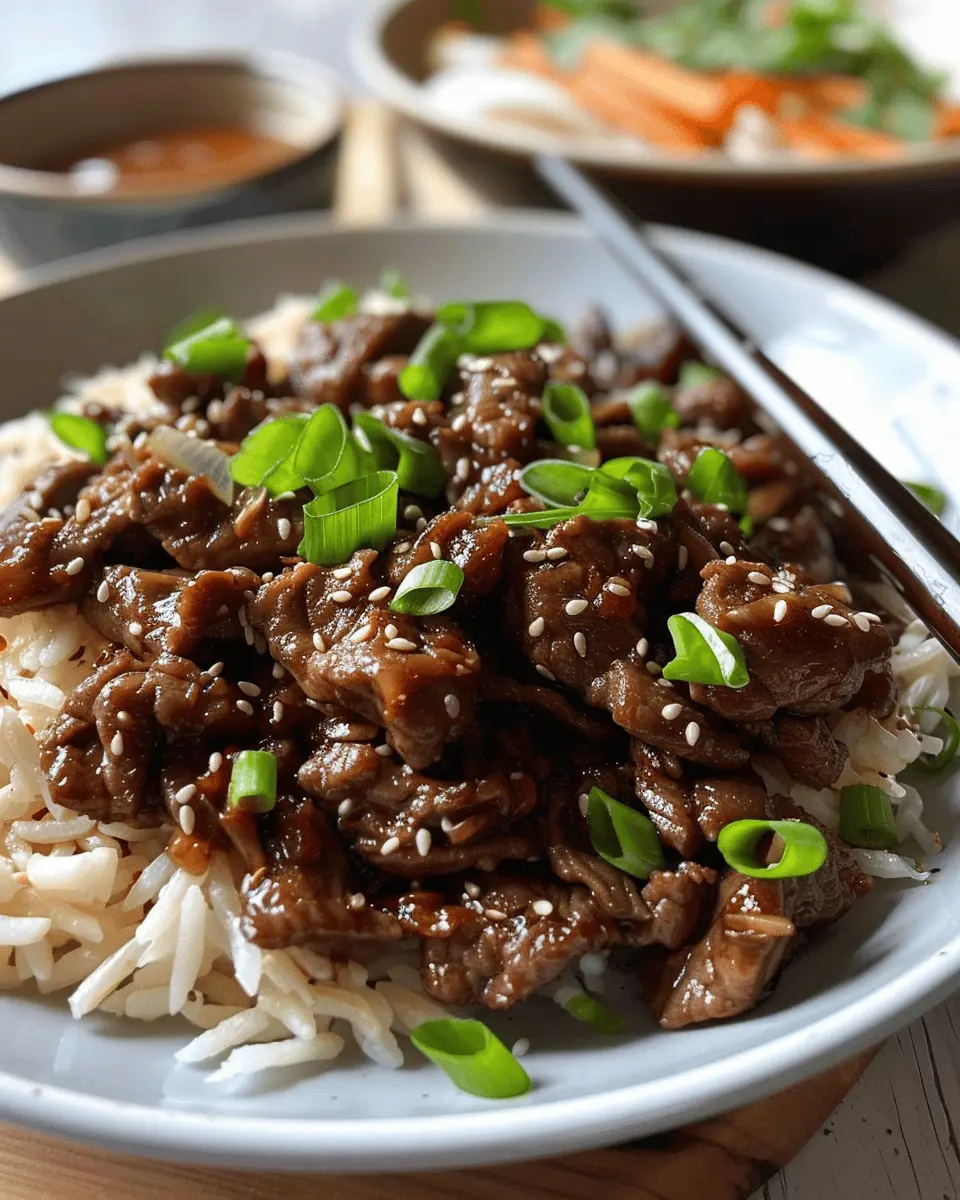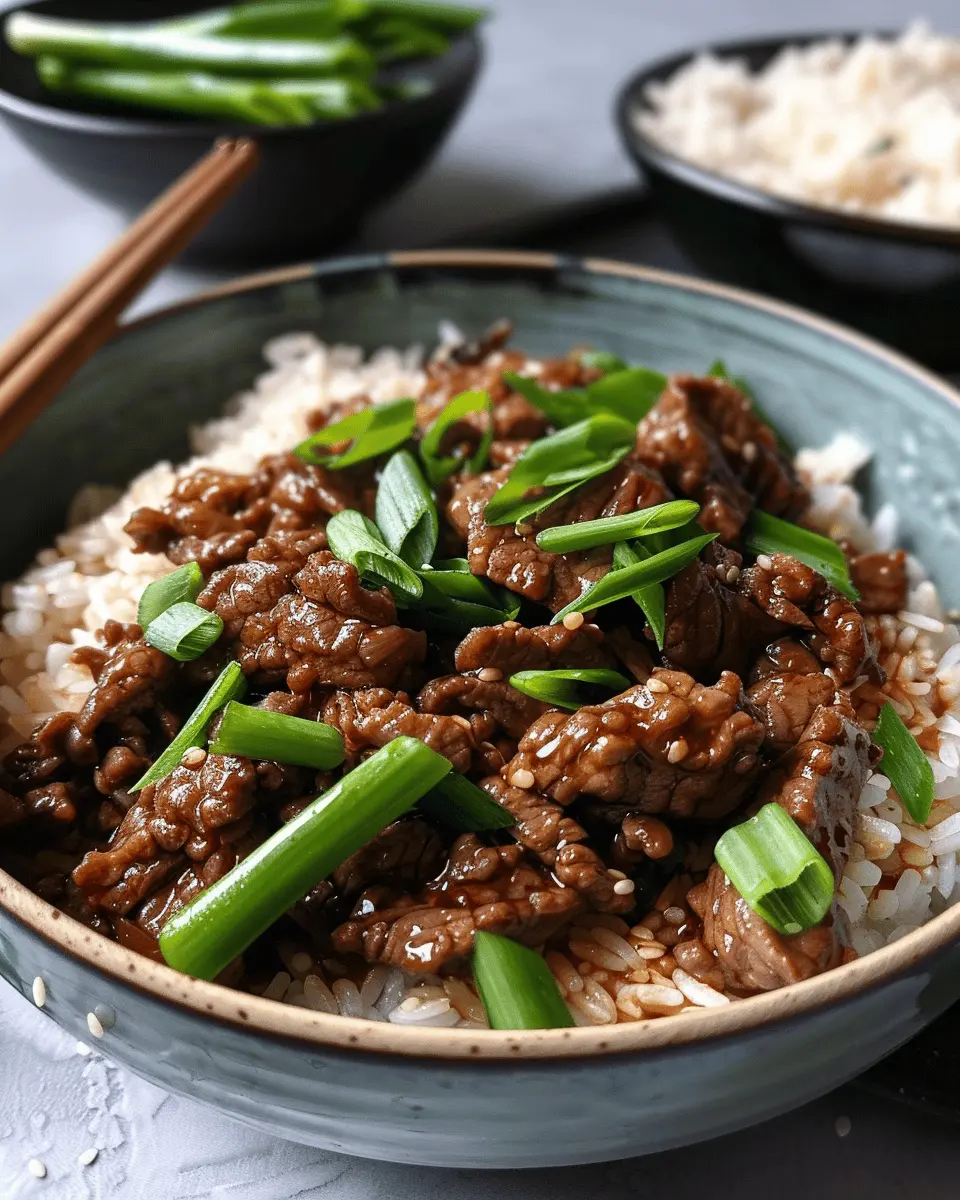Introduction to Mongolian Beef
Mongolian beef is a tantalizing dish that has won over the hearts (and taste buds) of food lovers around the globe. Originating in Chinese-American cuisine rather than Mongolia itself, this dish beautifully blends tender beef with soy sauce, scallions, and a hint of heat from chili paste or garlic. Its savory and slightly sweet flavor profile makes it a favorite in many households, especially for busy young professionals looking for a quick yet satisfying meal.
So, why is Mongolian beef so popular? First, it’s incredibly easy to make. In under 30 minutes, you can whip up a hearty meal that feels indulgent but requires minimal prep and effort. According to a survey by the National Restaurant Association, Asian cuisine has consistently grown in popularity over the past decade, and dishes like Mongolian beef showcase the bold flavors and vibrant ingredients that attract diners. Plus, the dish is flexible. You can enjoy it over a bed of rice, as part of a stir-fry, or even in a wrap for a modern twist.
Another reason for its widespread appeal is its adaptability. Using fresh vegetables, such as bell peppers and broccoli, can add nutritional value and color, making the dish as healthy as it is delicious. If you’re looking to personalize your Mongolian beef, consider adding a splash of sesame oil or swapping in different proteins, like chicken or turkey bacon, for a lighter option.
Let’s not forget the cultural influence surrounding Mongolian beef. Its mysterious name often sparks curiosity about Mongolian culture and cuisine, even prompting some young food lovers to explore authentic Mongolian flavors and ingredients. For those interested in learning more, the Mongolian National Cuisine offers a glimpse into the rich culinary heritage that inspired this beloved dish.
In essence, Mongolian beef isn’t just a meal; it’s an experience. Its rich flavors and easy preparation make it a staple for busy professionals, while its roots invite you to explore deeper culinary traditions. Ready to dive into making your own? Let’s get cooking!

Ingredients for Mongolian Beef
When it comes to perfecting your Mongolian beef dish, having the right ingredients is crucial. Let’s dive into what you’ll need to create this flavorful meal.
Main Ingredients
To make your Mongolian beef come alive, gather the following essentials:
- Beef: Flank steak or sirloin, thinly sliced against the grain for tender bites.
- Soy sauce: A must-have for that savory umami flavor. You can use low-sodium soy sauce if you’re watching sodium intake.
- Brown sugar: This adds a delightful sweetness that balances the savory elements.
- Garlic: Fresh minced garlic will elevate the flavor profile significantly.
- Ginger: Fresh ginger complements the dish with a zesty spice that energizes each bite.
- Green onions: Chopped, these add crunch and a hint of freshness.
Optional Ingredients
Spice things up a little with these optional extras:
- Turkey bacon: Adds an unexpected smokiness if you’re looking for unique flavors.
- Chicken ham: You can use this for additional protein or to mix things up!
- Chili flakes or fresh chilies: For those who crave a little heat.
- Sesame oil: A drizzle at the end can enhance the aroma and richness.
With these ingredients, you’re well on your way to whipping up a delicious plate of Mongolian beef. Happy cooking! For more ideas, check out this guide on Asian ingredients to expand your culinary pantry.
Step-by-step Preparation of Mongolian Beef
Cooking can be a wonderful experience, especially when it involves vibrant flavors and mouthwatering dishes. Today, we’re diving into the art of making Mongolian beef, a delightful recipe that promises to satisfy your taste buds. Follow these steps to bring a touch of Mongolia into your kitchen, and trust me, your friends will be lining up for seconds!
Marinating the Beef
The first step in our Mongolian beef journey is marinating the beef itself. This crucial process enhances the meat’s flavor profile and tenderness.
-
Choose the right cut: Opt for flank steak or sirloin; both of these cuts provide great flavor when cooked properly.
-
Create your marinade: In a bowl, combine:
-
2 tablespoons of soy sauce
-
1 tablespoon of cornstarch
-
1 teaspoon of garlic powder
-
1 tablespoon of sesame oil
This marinade not only tenderizes the beef but also infuses it with rich flavor. Let the beef marinate for at least 30 minutes at room temperature or up to two hours in the refrigerator.
Preparing the Fried Vermicelli (optional)
If you’re looking to elevate your Mongolian beef experience, consider adding a side of crispy fried vermicelli. It’s optional but highly recommended for that delightful crunch.
- Cook the vermicelli: Boil water and add about 120 grams of dried vermicelli noodles. Cook until just tender, then drain and let them cool.
- Fry the noodles: In a hot skillet, add some oil and fry them until they turn golden brown. Remove them from the pan and set aside. This step essentially gives you a delicious, crispy canvas to go with your main dish.
Feel adventurous? You can find more about noodles and their benefits on trusted cooking sites like Serious Eats.
Cooking the Mongolian Beef
Now we get to the exciting part—the cooking. This is where all the flavors start to meld beautifully.
- Heat your wok: Get your wok or a large pan hot over high heat. A well-seasoned wok can make a big difference in your dish.
- Sear the beef: Add a splash of oil, making sure it’s hot enough to sizzle. Fry the marinated beef in batches to avoid overcrowding. Each piece should cook for about 2-3 minutes until browned on the outside.
- Remove from wok: Once browned, take the beef out and set it aside.
Combining Flavors in the Wok
Now that we have our beautifully cooked beef, it’s time to bring the dish together with some additional flavor.
-
Prepare the sauce: In the same wok, add more oil if necessary and toss in:
-
3 tablespoons of soy sauce
-
2 tablespoons of brown sugar
-
2-3 minced garlic cloves
-
1 tablespoon of grated ginger
-
Sliced green onions
Cook this mixture for a minute or until it starts to bubble. The aroma will be fantastic, and you’ll already start to sense how delicious this will be!
-
Return the beef: Add your previously cooked beef back into the wok, tossing everything together until evenly coated in that savory sauce. If you prefer a thicker sauce, a teaspoon of cornstarch mixed with water can help.
Serving the Dish
Presentation can elevate any dish, so let’s make this Mongolian beef shine!
- Assemble your plate: Grab a plate and layer a bed of crispy fried vermicelli (if you chose to make it), and then generously top it with your sautéed Mongolian beef.
- Garnish: Don’t forget to sprinkle more green onions or sesame seeds on top for that finishing touch.
Serve immediately and relish the blend of flavors in every bite. Whether you’re inviting friends over or enjoying a quiet night at home, this dish is sure to impress. You can find more variations of this recipe at Food Network.
So, what do you say? Are you ready to dive into the delicious world of Mongolian beef? Enjoy your cooking adventure!

Variations on Mongolian Beef
When you think of Mongolian beef, you might picture tender strips of beef glistening in a savory soy-based sauce. But did you know there are some exciting variations that you can explore? Here are a couple of ways to make this dish your own!
Spicy Mongolian Beef
If you love a kick in your meals, consider turning up the heat with Spicy Mongolian Beef. Simply add sliced fresh peppers—like jalapeños or Thai chilies—along with your beef in the frying pan. You can also include a splash of sriracha or chili paste in the sauce for that extra zing. According to a report by the National Institutes of Health, spicy foods can boost metabolism and enhance flavor, making your meal both delicious and beneficial. Just be careful; it’s easy to go overboard!
Vegetarian Mongolian Beef Options
For those seeking a plant-based twist, Vegetarian Mongolian Beef options are now easier than ever to make! Swap out the beef for hearty vegetables or protein alternatives like seitan or tofu. Marinate the protein in the same soy sauce mixture as the beef, then follow the same cooking methods. This adaptation allows you to still enjoy that savory flavor profile while keeping it meat-free. Plus, you can sneak in more veggies like bell peppers and broccoli for added nutrition.
Whether you’re craving something spicier or looking to cater to a more vegetarian crowd, these variations make Mongolian beef not just a dish but a canvas for culinary creativity! For more innovative recipes, check out Serious Eats or America’s Test Kitchen for inspiration.
Cooking Tips and Notes for Mongolian Beef
Marination Tips for Maximum Flavor
To elevate your Mongolian beef, marination is essential. Aim for at least 30 minutes, but if you can allow it to sit for 2-4 hours, that’s even better! A good marinade includes soy sauce, garlic, and a bit of ginger. This combination perks up the flavors and tenderizes the beef. If you have time, consider using a vacuum-seal bag; it helps the marinade penetrate deeper.
Tips for Cutting Beef Thinly
Cutting your beef thinly is crucial for that tender bite. Here are some tips:
- Chill the Beef: Place it in the freezer for about 30 minutes. This firms it up, making it easier to slice.
- Against the Grain: Always cut against the grain to ensure tenderness. Look for the lines in the meat, and slice perpendicular to them.
- Sharp Knife: A sharp knife will make a difference! If possible, use a chef’s knife for precision.
For more expert tips on meat preparation, check out the USDA’s guidelines.
By following these steps, you can ensure your Mongolian beef is flavorful and perfectly textured, making for a dish that’s sure to impress. Happy cooking!

Serving Suggestions for Mongolian Beef
Side Dishes That Complement Mongolian Beef
When it comes to Mongolian beef, the right side dishes can elevate your meal experience. Here are some delightful options:
- Steamed Rice: A classic choice, rice absorbs the rich sauce and balances the flavors perfectly.
- Stir-Fried Vegetables: Broccoli, bell peppers, and snap peas add a vibrant touch and an additional crunch.
- Egg Fried Rice: For a twist, consider adding eggs to your fried rice for extra protein and flavor.
- Noodles: Lo mein or rice noodles are fantastic if you’re craving something heartier.
Thinking of a crunchy side? Try cucumber salad dressed in soy sauce and sesame oil for a refreshing kick!
Ideal Plating for Presentation
Now, let’s talk about how to make your Mongolian beef the star of your dinner table.
- Layering: Start with a bed of steamed rice or noodles, creating a base.
- Heaping Your Beef: Place the Mongolian beef slightly off-center, allowing the inviting sauce to drip over the rice.
- Garnish: A sprinkle of sliced green onions and sesame seeds adds that professional touch, making the dish pop visually.
Remember, first impressions matter! Making your plate visually appealing can enhance the dining experience, inviting your guests to dive right in.
If you’re curious about more serving ideas, check out the Food Network for additional inspiration!
Time Breakdown for Making Mongolian Beef
When you’re ready to whip up a delightful plate of Mongolian Beef, knowing the timing can really enhance your kitchen experience. Here’s how it breaks down:
Preparation Time
Setting aside about 15-20 minutes for preparation is ideal. This includes slicing the beef into thin strips, marinating it, and chopping your aromatic veggies like green onions. If you want everything to flow smoothly, consider doing this ahead of time.
Cooking Time
Once you hit the stove, you’ll be looking at around 10-15 minutes to cook. This quick frying process brings all those wonderful flavors together while keeping the beef tender and juicy.
Total Time
In just about 30-35 minutes, you’ll have a delicious plate of Mongolian Beef ready to serve! Perfect for a weeknight dinner that’s both satisfying and quick.
For more insights on beef cooking times and tips, check out resources like the USDA’s guidelines for safe cooking practices. Happy cooking!
Nutritional Facts for Mongolian Beef
When whipping up a delicious dish like Mongolian beef, it’s always a good idea to keep track of the nutritional content. Here’s a breakdown of the key nutritional facts that make this dish both satisfying and nourishing.
Calories
A typical serving of Mongolian beef contains approximately 350-450 calories, depending on portion size and preparation method. This makes it a hearty choice for lunch or dinner without throwing off your daily calorie goals.
Protein
Packed with protein, a serving of Mongolian beef can contain around 25-35 grams. This nutrient is essential for muscle repair and growth, making it a great post-workout meal choice. For more insights on protein sources, check this Healthline article.
Sodium
It’s important to mind the sodium content, which can range from 700 to 1,200 mg per serving, influenced by soy sauce and other seasonings. If you’re looking to cut back on salt, consider using low-sodium soy sauce as a fantastic alternative. For tips on managing sodium intake, see this American Heart Association guide.
By being mindful of these nutritional aspects, you can savor your Mongolian beef dish while still adhering to your dietary preferences and needs!
FAQs about Mongolian Beef
When diving into the delicious world of Mongolian beef, you may have some questions about perfecting this dish. Don’t worry; we’ve got you covered!
How can I make Mongolian Beef less sweet?
If you find that traditional Mongolian beef recipes lean a bit too much toward the sweet side, there are simple tweaks you can make.
- Reduce the sugar: Start by cutting down the amount of brown sugar used in the recipe—try halving it and adjusting to taste.
- Add acidity: A splash of vinegar or lemon juice can help cut the sweetness. Just be careful not to overdo it; a little goes a long way!
- Incorporate savory elements: Increasing the amount of garlic or ginger can balance sugar’s sweetness with robust flavors.
What can I substitute for Shaoxing rice wine?
Shaoxing rice wine is a common ingredient in many Asian dishes, but if you want to make a Mongolian beef recipe without it, don’t fret.
- Chicken broth: This can provide a similar flavor without the alcohol. Consider using low-sodium varieties for controlled salt levels.
- Apple cider vinegar: Dilute it with a bit of water to mimic the acidity of rice wine. A 3:1 ratio usually works well!
Can Mongolian Beef be made ahead of time?
Absolutely! In fact, many home cooks swear that Mongolian beef tastes even better the next day. Here’s how to prep it in advance:
- Cook and chill: Make your Mongolian beef, then allow it to cool completely before storing it in an airtight container in the fridge for up to three days.
- Reheat properly: When you’re ready to serve, gently reheat it on the stovetop, adding a splash of broth to keep it from drying out.
For more tips on meal prep, check out this article for helpful ideas! Happy cooking!
Conclusion on Mongolian Beef
Why you’ll love making Mongolian Beef at home
Making Mongolian Beef at home is not just about enjoying a delicious meal; it’s about the joy of cooking and sharing. You’ll love the aroma that fills your kitchen as the beef marinates and the vibrant colors of the vegetables come to life. Plus, it’s an excellent dish to impress friends or add to your dinner repertoire.
By using fresh ingredients, you can customize flavors to suit your taste. Give it a try, and you might find that this easy dish becomes a go-to for your weeknight dinners. Don’t miss out on the opportunity to create your own culinary masterpiece! For more insights on Asian recipes, check out Serious Eats.
PrintMongolian Beef: Easy Recipe for a Flavorful Family Dinner
Mongolian Beef is a delicious and easy-to-make dish that your whole family will love. This recipe features tender beef in a rich and savory sauce that’s perfect over rice or noodles.
- Prep Time: 10 minutes
- Cook Time: 15 minutes
- Total Time: 25 minutes
- Yield: 4 servings 1x
- Category: Dinner
- Method: Stovetop
- Cuisine: Asian
- Diet: Gluten-free
Ingredients
- 1 pound flank steak, sliced thin
- 2 tablespoons cornstarch
- 1 tablespoon vegetable oil
- 1 cup soy sauce
- 1 cup brown sugar
- 1 tablespoon minced garlic
- 1 tablespoon grated ginger
- 2 green onions, chopped
Instructions
- In a bowl, toss the sliced flank steak with cornstarch until well coated.
- Heat the vegetable oil in a large pan over medium-high heat.
- Add the beef to the pan and cook until browned, about 4-5 minutes.
- In a separate bowl, mix the soy sauce, brown sugar, garlic, and ginger.
- Pour the sauce over the beef and stir to combine.
- Cook for an additional 2-3 minutes until the sauce thickens.
- Stir in the green onions and remove from heat.
- Serve over rice or noodles.
Notes
- For extra flavor, add some red pepper flakes.
- Store leftover Mongolian Beef in an airtight container in the refrigerator for up to 3 days.
Nutrition
- Serving Size: 1 cup
- Calories: 350
- Sugar: 15 grams
- Sodium: 800 mg
- Fat: 10 grams
- Saturated Fat: 2 grams
- Unsaturated Fat: 6 grams
- Trans Fat: 0 grams
- Carbohydrates: 45 grams
- Fiber: 1 gram
- Protein: 25 grams
- Cholesterol: 70 mg
Keywords: Mongolian Beef, family dinner, easy recipe












